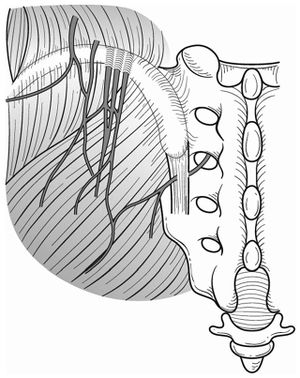◔
Superior Cluneal Nerve Entrapment: Difference between revisions
From WikiMSK
No edit summary |
No edit summary |
||
| Line 4: | Line 4: | ||
==Anatomy== | ==Anatomy== | ||
[[File:Superior and middle cluneal nerves.jpg|thumb|right|Superior and middle cluneal nerves with typical entrapment sites. Multiple branches of the superior cluneal nerves can be entrapped where they pierce the thoracolumbar fascia over the iliac crest. Middle cluneal nerve entrapment can occur where it passes under or through the long posterior sacroiliac ligament.{{#pmid:27004164|Aota}}]] | [[File:Superior and middle cluneal nerves.jpg|thumb|right|Superior and middle cluneal nerves with typical entrapment sites. Multiple branches of the superior cluneal nerves can be entrapped where they pierce the thoracolumbar fascia over the iliac crest. Middle cluneal nerve entrapment can occur where it passes under or through the long posterior sacroiliac ligament.{{#pmid:27004164|Aota}}]] | ||
==Treatment== | |||
===Surgery=== | |||
Reports have been published on superior cluneal nerve release and middle cluneal nerve release. | |||
==References== | ==References== | ||
| Line 9: | Line 14: | ||
{{Reliable sources}} | {{Reliable sources}} | ||
[[Category:Stubs]] | [[Category:Stubs]] | ||
[[Category:Sacroiliac Joint]] | |||
Revision as of 13:33, 7 September 2020
This article is a stub.
Anatomy

Superior and middle cluneal nerves with typical entrapment sites. Multiple branches of the superior cluneal nerves can be entrapped where they pierce the thoracolumbar fascia over the iliac crest. Middle cluneal nerve entrapment can occur where it passes under or through the long posterior sacroiliac ligament.[1]
Treatment
Surgery
Reports have been published on superior cluneal nerve release and middle cluneal nerve release.
References
Literature Review
- Reviews from the last 7 years: review articles, free review articles, systematic reviews, meta-analyses, NCBI Bookshelf
- Articles from all years: PubMed search, Google Scholar search.
- TRIP Database: clinical publications about evidence-based medicine.
- Other Wikis: Radiopaedia, Wikipedia Search, Wikipedia I Feel Lucky, Orthobullets,


